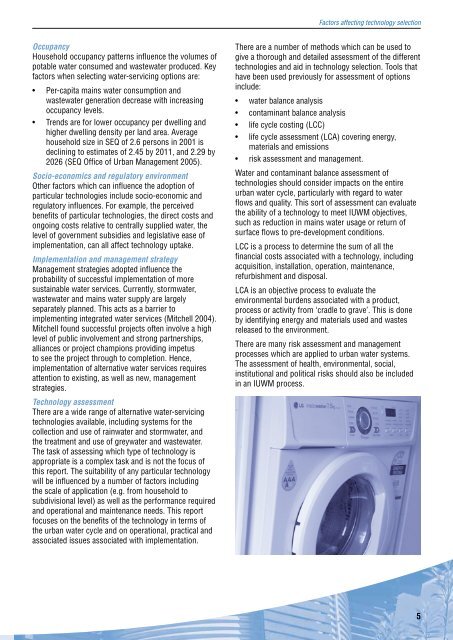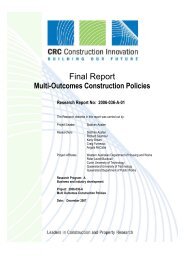SEQ — Current strategies andinitiativesStrategies and initiatives in place to achieve reductionsin water use in SEQ include:••••••mandatory water restrictions on outdoor water useWSUD, rainwater tank rebates, and retrofi tting(including redesign and re-engineering) incentivesrequirements for water recycling and effi cientappliances in new developmentswater recycling targets‘fi t-for-purpose’ strategies for major industrial andcommercial usersprogressive upgrades of capacity in wastewatertreatment facilities.These approaches also support the SEQ Regional WaterSupply Strategy mains water consumption targets of270L/capita/day by 2010 and 230L/capita/day by 2020(Department of Natural Resources and Mines 2006),which are reductions from the 2004 regional average of300L/capita/day (Australian Water Association 2005).The targets should be readily achievable in Brisbane andthe Gold Coast where residential use has been less than270L/capita/day for most of the previous fi ve years.However, other SEQ areas may fi nd these targets harderto achieve if, as the Australian Water Association datasuggests, some have much higher water consumption;for example, residential use in Beaudesert, Caloundra,Cooloola and Noosa at 370L/capita/day.In SEQ, the installation of greywater systems hasrecently been accepted by the State Government, withfi nal approval still resting with local councils. Systemtype and management are important factors to consider,as some uncertainty exists regarding the potentialimpacts of greywater on soils and runoff water quality.Whilst there has been national coverage of stormwateruse, the Stormwater Industry Association Queenslandhas expressed concern that the SEQ Regional Plandid not highlight the resource value of stormwater(Stormwater Industry Association Queensland 2006).The Message from the Minister in the Towards<strong>Sustainable</strong> Housing in Queensland Discussion Paper(Department of Local Government, Planning, Sport andRecreation 2004) suggests the use of water effi cientappliances, rainwater tanks and pressure reductiondevices as potential future options. The introductionof new water-saving measures followed a communityconsultation process of the discussion paper.New measures include the promotion of greywaterand rainwater systems as well as various demandmanagement approaches. These are being implementedthrough the Standard Building Amendment Regulation(No. 1) 2006 which references Rainwater Tanks(Part 25) and <strong>Sustainable</strong> Buildings (Part 29) of theQueensland Development Code.Some local governments in SEQ have a policy thatall new urban developments refl ect WSUD principlesby 2010 (e.g. Brisbane City Council 2005b). Thissound initiative, however, does not specify householdwater consumption targets to be achieved by newdevelopments.Factors affecting technologyselectionThis section describes some of the key factorsinfl uencing the selection of alternative water-servicingapproaches in residential <strong>subdivisions</strong>. All these factorsinfl uence appropriate applications of given technologiesand the viability of potential options. A summary ofassessment techniques is also included.ClimateLocal climate infl uences selection of approaches towater servicing. While average annual rainfall is acritical indicator of available water in a new or existingsubdivision, other factors must also be considered,including the variation in annual, monthly and dailyrainfall and evaporation rates, and the climate’sinfl uence on water use, especially for irrigation.TopographyTopography can dictate plot and infrastructure layout,with graded slopes being the more desirable terrain.Steeper slopes impose more constraints on style andform of construction.Steeper slopes lead to greater surface fl ows and loadswhich can increase sewage pumping and costs. Onthe other hand, slope can be exploited to allow gravityto assist in collection and supply of natural water orwastewater fl ows.Lot size and densityFor most developments, lot size is strongly infl uencedby the fi nancial viability of the development; however,changing demographics, dwelling types, consumerexpectations and affordability are also infl uential. Lotsize affects selection of water-servicing strategies. Forexample:• A large irrigation area is required to distributeand absorb treated wastewater for many on-sitewastewater treatments.• Rainwater tanks and stormwater collection systemsmay need large areas to capture and store watervolumes required for reliable supply.Lot size and density also affect the capacity for largescalemanagement of stormwater and wastewater in wetmonths suffi cient to cover supply in dry periods.4
Factors affecting technology selectionOccupancyHousehold occupancy patterns infl uence the volumes ofpotable water consumed and wastewater produced. Keyfactors when selecting water-servicing options are:• Per-capita mains water consumption andwastewater generation decrease with increasingoccupancy levels.• Trends are for lower occupancy per dwelling andhigher dwelling density per land area. Averagehousehold size in SEQ of 2.6 persons in 2001 isdeclining to estimates of 2.45 by 2011, and 2.29 by2026 (SEQ Offi ce of Urban Management 2005).Socio-economics and regulatory environmentOther factors which can infl uence the adoption ofparticular technologies include socio-economic andregulatory infl uences. For example, the perceivedbenefi ts of particular technologies, the direct costs andongoing costs relative to centrally supplied water, thelevel of government subsidies and legislative ease ofimplementation, can all affect technology uptake.Implementation and management strategyManagement strategies adopted infl uence theprobability of successful implementation of moresustainable water services. Currently, stormwater,wastewater and mains water supply are largelyseparately planned. This acts as a barrier toimplementing integrated water services (Mitchell 2004).Mitchell found successful projects often involve a highlevel of public involvement and strong partnerships,alliances or project champions providing impetusto see the project through to completion. Hence,implementation of alternative water services requiresattention to existing, as well as new, managementstrategies.Technology assessmentThere are a wide range of alternative water-servicingtechnologies available, including systems for thecollection and use of rainwater and stormwater, andthe treatment and use of greywater and wastewater.The task of assessing which type of technology isappropriate is a complex task and is not the focus ofthis report. The suitability of any particular technologywill be infl uenced by a number of factors includingthe scale of application (e.g. from household tosubdivisional level) as well as the performance requiredand operational and maintenance needs. This reportfocuses on the benefi ts of the technology in terms ofthe urban water cycle and on operational, practical andassociated issues associated with implementation.There are a number of methods which can be used togive a thorough and detailed assessment of the differenttechnologies and aid in technology selection. Tools thathave been used previously for assessment of optionsinclude:•••••water balance analysiscontaminant balance analysislife cycle costing (LCC)life cycle assessment (LCA) covering energy,materials and emissionsrisk assessment and management.Water and contaminant balance assessment oftechnologies should consider impacts on the entireurban water cycle, particularly with regard to waterfl ows and quality. This sort of assessment can evaluatethe ability of a technology to meet IUWM objectives,such as reduction in mains water usage or return ofsurface fl ows to pre-development conditions.LCC is a process to determine the sum of all thefi nancial costs associated with a technology, includingacquisition, installation, operation, maintenance,refurbishment and disposal.LCA is an objective process to evaluate theenvironmental burdens associated with a product,process or activity from ‘cradle to grave’. This is doneby identifying energy and materials used and wastesreleased to the environment.There are many risk assessment and managementprocesses which are applied to urban water systems.The assessment of health, environmental, social,institutional and political risks should also be includedin an IUWM process.5
















